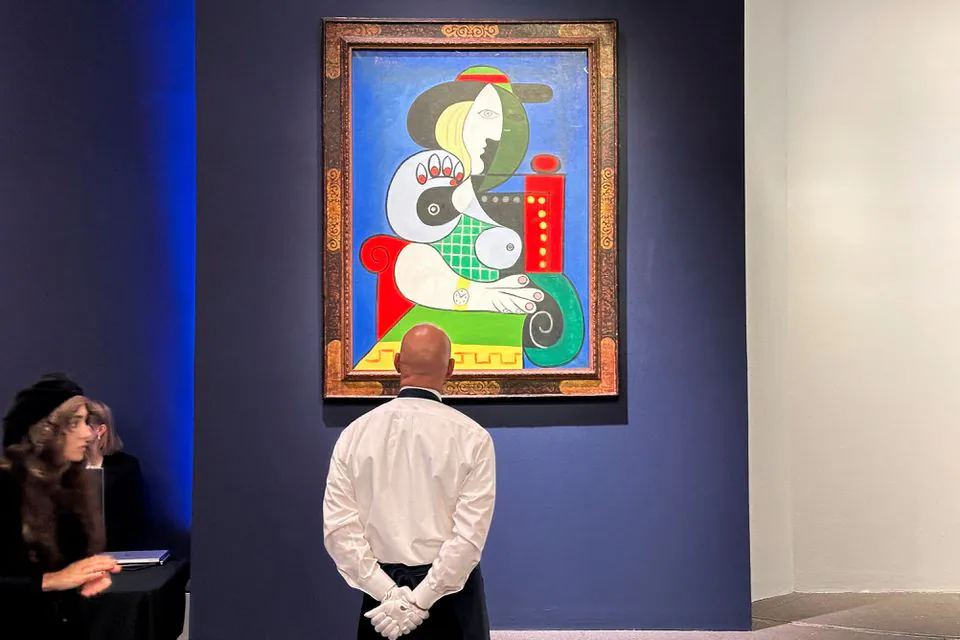
On a crisp autumn evening at Sotheby's New York, the echoes of history reverberated as Pablo Picasso's masterful 1932 painting, "Femme à la montre" ("Woman with a Watch"), made waves in the art world. With a resounding thud of the auctioneer's gavel, the painting fetched a staggering $139 million, firmly establishing it as the most valuable work of art sold globally at auction this year. This record-breaking sale is not merely a financial triumph; it is a celebration of Picasso's enduring influence and the resilience of the art market.
A Price Tag That Echoes Through Time
The allure of Picasso's "Femme à la montre" lies not only in its captivating portrayal but also in the storied history that accompanies it. The painting, a portrait of Picasso's lover Marie-Thérèse Walter, seated regally against a vibrant blue backdrop, encapsulates the artist's distinctive style. The titular wristwatch, a recurring motif in Picasso's works featuring his wife Olga Khokhlova, adds a layer of symbolism to the composition.
The sale, part of an estimated $400 million auction of the late philanthropist Emily Fisher Landau's collection, positions "Femme à la montre" as the bellwether for the fall art auction season in New York. Landau's curated collection became a testament to her discerning taste, and Picasso's masterpiece took center stage, eclipsing all other works to emerge as the pinnacle of artistic value in 2023.
Picasso's Complex Love and Artistic Expression
Marie-Thérèse Walter entered Picasso's life at a pivotal juncture. At 17 years old, she crossed paths with the 45-year-old artist in Paris, sparking a clandestine relationship that unfolded while Picasso was still married to Khokhlova. "Femme à la montre" is a poignant representation of Walter seated in a throne-like chair, her enigmatic gaze and the ticking wristwatch capturing the essence of a moment frozen in time.
Walter served as Picasso's muse, inspiring numerous artworks that delved into the depths of love, passion, and desire. The painting becomes a visual symphony of emotions, a testament to Picasso's ability to translate complex human relationships onto canvas. The artist's portrayal of Walter in "Femme à la montre" and the subsequent 1932 painting "Femme nue couchée," which fetched $67.5 million at auction in 2022, solidify her place in the annals of art history.
A Pivotal Year for Picasso
The year 1932 marked a crucial chapter in Picasso's illustrious career. At 50 years old, having already achieved widespread acclaim, Picasso found himself at a crossroads. The Tate Modern museum notes that he intensified his artistic ambitions in 1932, a response to critics questioning whether he was an artist of the past or the future. "Femme à la montre" emerged from this pivotal period, capturing Picasso's determination to silence doubters and affirm his enduring legacy.
From Mantle to Auction Block: The Journey of "Femme à la montre"
Emily Fisher Landau, a discerning art collector, acquired "Femme à la montre" from New York's Pace Gallery in 1968. For decades, the painting adorned the mantle in her Manhattan apartment, a silent witness to the evolving art scene and societal changes. Landau's decision to part with this iconic piece of art marked a transition, not just in ownership but in the ongoing narrative of Picasso's masterpiece.
The Anonymous Bidder and the Symphony of Art
As the auction unfolded at Sotheby's, "Femme à la montre" became the focal point of a bidding war that culminated in a triumphant victory for an anonymous buyer. Outbidding two other contenders, this discerning collector recognized the rarity and significance of Picasso's work, cementing the painting's place in the upper echelons of art history.
The Broader Implications for the Art Market
Beyond the staggering price tag, Picasso's "Femme à la montre" holds broader implications for the art market. Its record-breaking sale not only reaffirms the enduring appeal of iconic masterpieces but also underscores the market's resilience. In a world that has weathered economic uncertainties and global challenges, the art market continues to stand as a bastion of creativity, cultural appreciation, and financial investment.
Conclusion: A Symphony of Value and Legacy
Picasso's "Femme à la montre" has transcended its role as a mere painting; it has become a symphony of value, legacy, and artistic prowess. The $139 million price tag, while a testament to the financial prowess of the art market, is also a celebration of Picasso's ability to encapsulate the complexities of human emotion on canvas. As the masterpiece changes hands, it carries with it the weight of history and the promise of endurance—a timeless reminder of the enduring power of art.








